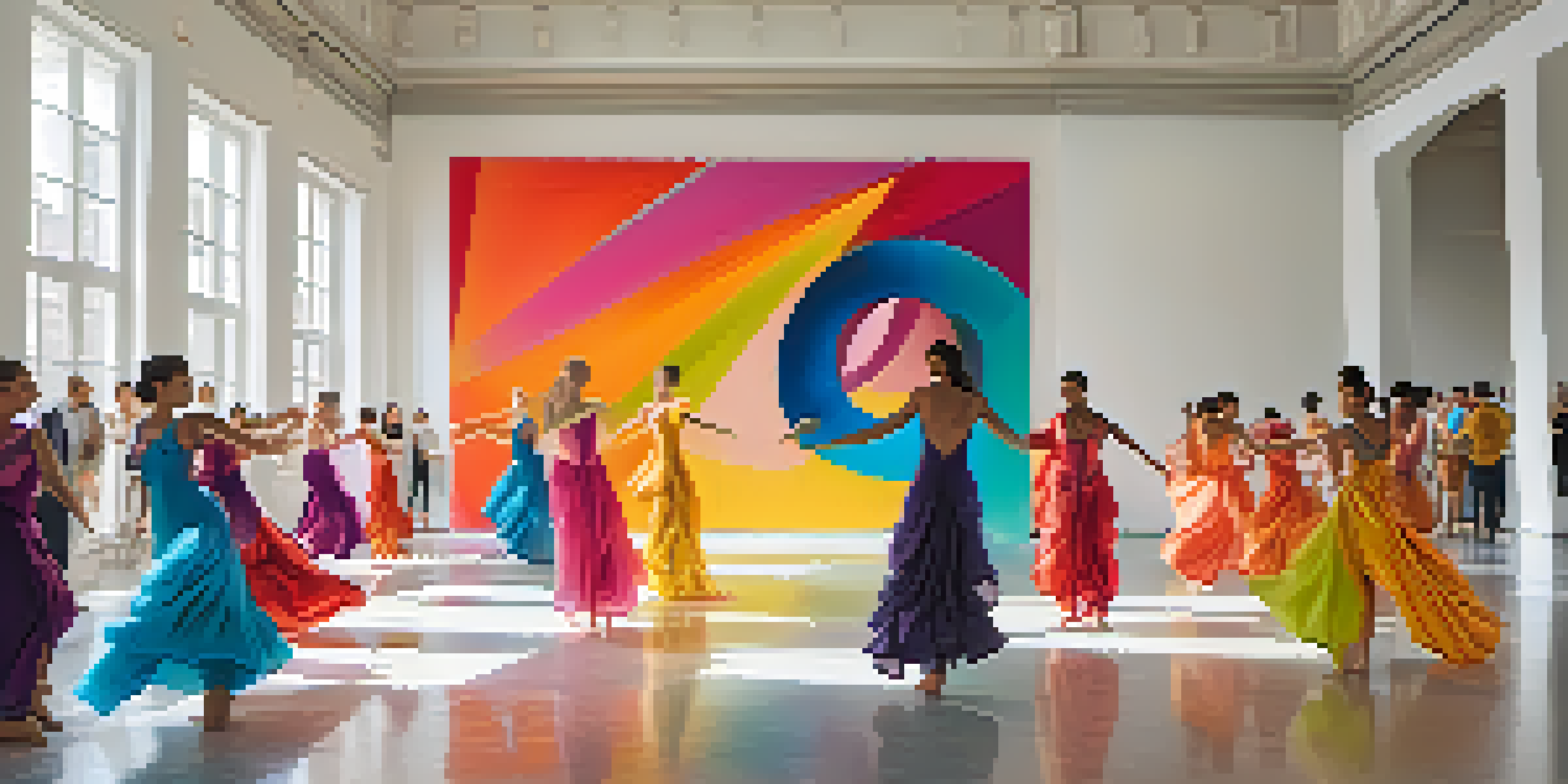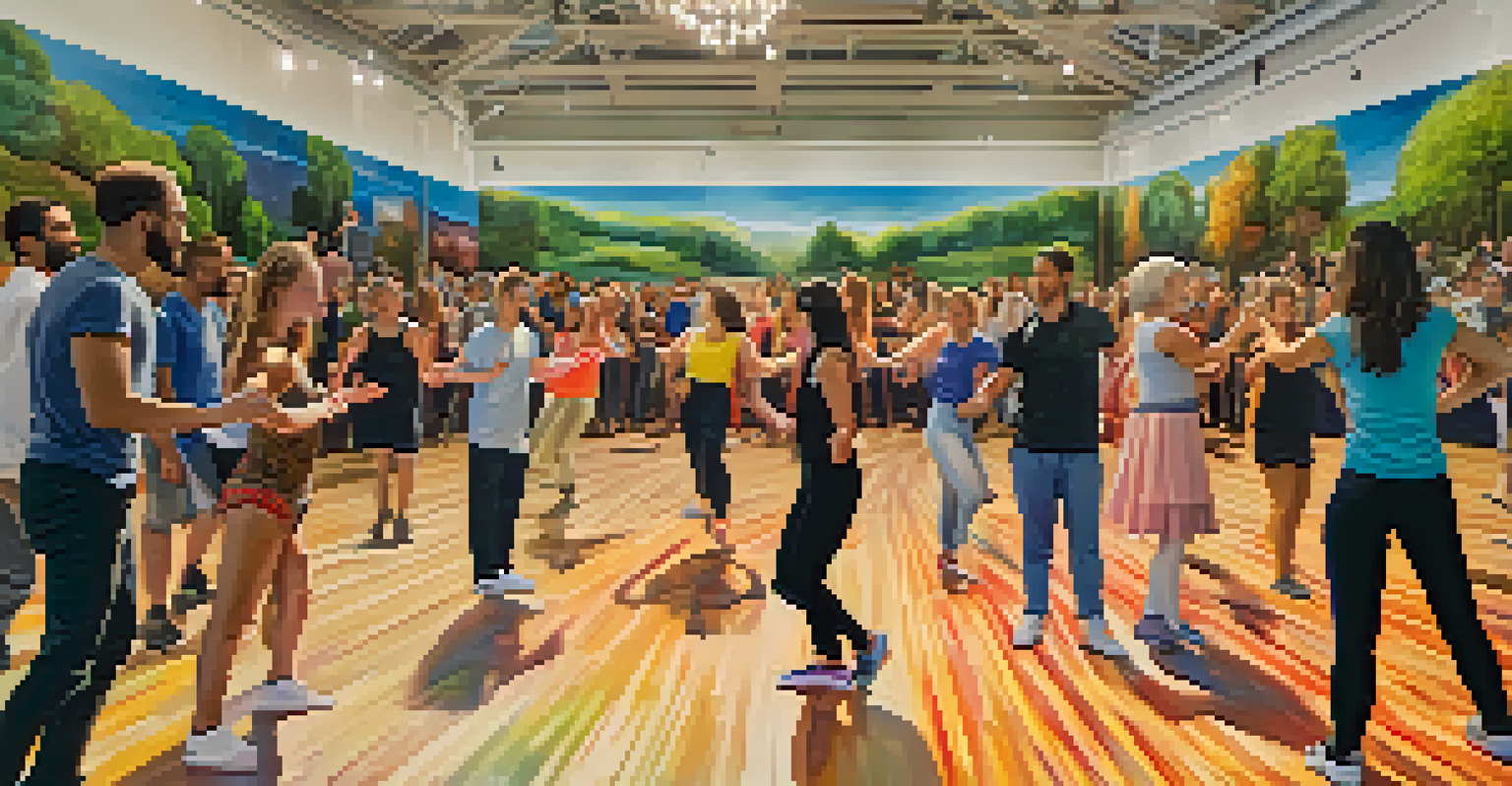The Impact of Dance on Contemporary Visual Art Installations

Understanding the Relationship Between Dance and Visual Art
Dance and visual art might seem like different worlds, but they share a deep connection. Both forms express human emotion and experience, often complementing each other in powerful ways. When artists blend movement with visual media, they create a dynamic dialogue that captivates audiences and enhances interpretation.
Dance is the hidden language of the soul.
For instance, a performance featuring dancers interacting with sculptures can transform static art into a living experience. This interplay invites viewers to engage not just with what they see, but with what they feel, bridging the gap between observation and emotion. It's this synergy that makes contemporary installations so compelling.
Ultimately, understanding this relationship opens up new avenues for creativity. Artists can draw inspiration from each medium, expanding their horizons and challenging traditional boundaries. This melding of art forms pushes the envelope of what we consider art in today's landscape.
Historical Context: Dance in Art Through the Ages
Dance has been a subject in visual art for centuries, from ancient cave paintings depicting movement to classical sculptures capturing the grace of the human form. However, its role has evolved significantly over time. In contemporary settings, we see a more interactive approach where the act of dancing itself becomes part of the art piece.

Consider the works of artists like Marina Abramović, who incorporates performance art as a vital element of her installations. These interactions challenge the audience's perceptions and invite them to experience the art in a unique, immersive way. They are not just passive observers; they become participants in the artwork.
Dance and Art Share Deep Connection
Both dance and visual art express human emotion and experience, creating a dynamic dialogue that enhances audience engagement.
This historical evolution reflects broader cultural shifts and an increased appreciation for the body as a medium of expression. As dance continues to influence visual art, it also redefines artistic practice, allowing for a richer exploration of themes such as identity, community, and emotion.
The Role of Performance in Art Installations
Performance art, with its emphasis on live action, introduces a temporal dimension to visual art installations. Unlike traditional art forms, performance art unfolds over time, creating a sense of immediacy and engagement. This aspect allows viewers to witness the creative process, making them feel more connected to the work.
Art is not what you see, but what you make others see.
For example, installations that feature live dancers can evoke a range of emotions, from joy to melancholy, depending on the choreography and music. This emotional resonance elevates the viewing experience, encouraging audiences to reflect on their own feelings and experiences. It's an invitation to not just watch, but to feel and engage.
In this way, the incorporation of dance transforms static spaces into vibrant environments. The art installation becomes a living, breathing entity, constantly changing with each performance, and offering new insights with every interaction.
Exploring Themes: Identity and Movement
Dance often serves as a powerful medium for exploring themes of identity and self-expression. In contemporary visual art, these themes are frequently highlighted through choreography and movement. Artists use dance to comment on cultural narratives, personal experiences, and societal issues, creating a rich tapestry of meaning.
For instance, choreographers may collaborate with visual artists to depict cultural rituals or personal stories through dance, allowing audiences to witness the complexity of identity. This collaboration creates a multi-layered experience, merging the physical act of dancing with visual storytelling, making the themes more relatable and profound.
Interactivity Engages Audiences
Dance installations often invite audience participation, transforming viewers into active participants and fostering a sense of community.
As viewers engage with these installations, they are prompted to reflect on their own identities and experiences. This exploration fosters a deeper understanding of the human experience, bridging gaps between diverse perspectives and encouraging empathy.
Interactivity: Engaging Audiences Through Movement
In the realm of contemporary art, interactivity is key to engaging audiences. Dance installations frequently invite viewers to participate, blurring the lines between artist and audience. This involvement transforms the experience from passive observation to active participation, making art more accessible and relatable.
For example, installations where viewers are encouraged to join dancers can create a sense of community and shared experience. Participants might find themselves moving in tandem with the performers, breaking down barriers and fostering connections. This communal aspect amplifies the emotional impact of the piece.
Moreover, such interactions allow artists to gather real-time feedback, informing their practice and evolving their work. This cycle of engagement not only enriches the artistic process but also deepens the audience's connection to the art, creating lasting memories.
Technological Innovations: Enhancing Dance in Art
As technology continues to advance, it brings exciting new possibilities to the intersection of dance and visual art. Artists now incorporate digital elements, such as projections and interactive installations, that enhance the experience of both the dance and the art. This fusion allows for a more immersive and multi-dimensional approach.
For instance, augmented reality can enable viewers to engage with dance performances in ways that were previously unimaginable. Imagine a virtual dance partner that responds to your movements, creating a unique dialogue between the viewer and the art. These innovations can transform the audience's perception and understanding of the work.
Technology Transforms Art Experiences
Advancements in technology, like augmented reality, enhance the integration of dance and visual art, creating immersive and innovative experiences.
Additionally, technology can help document and archive performances, allowing them to be experienced long after the live event. This preservation ensures that the dialogue between dance and visual art continues, extending the reach of the artists’ messages and ideas.
The Future of Dance in Visual Art Installations
Looking ahead, the future of dance in visual art installations appears vibrant and full of potential. As artists continue to explore this intersection, we can expect to see more innovative collaborations that challenge traditional boundaries. The merging of dance and visual art not only creates captivating experiences but also encourages dialogue about culture, identity, and community.
Emerging artists, in particular, are eager to experiment with new forms and technologies, pushing the limits of what we define as art. By embracing diverse perspectives and techniques, the future of these installations promises to be even more inclusive and dynamic.

Ultimately, the impact of dance on contemporary visual art installations will continue to evolve, reflecting societal changes and the ever-shifting landscape of artistic expression. As audiences, we can look forward to engaging experiences that resonate on both personal and collective levels.